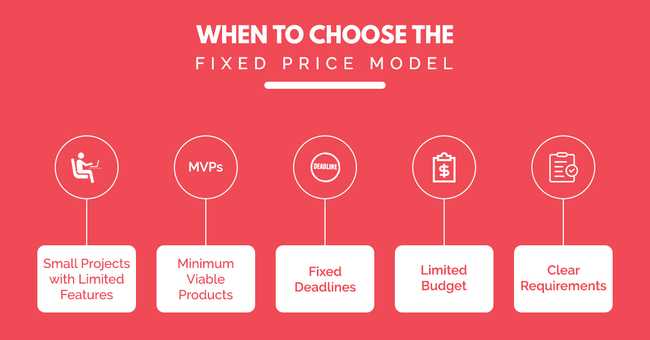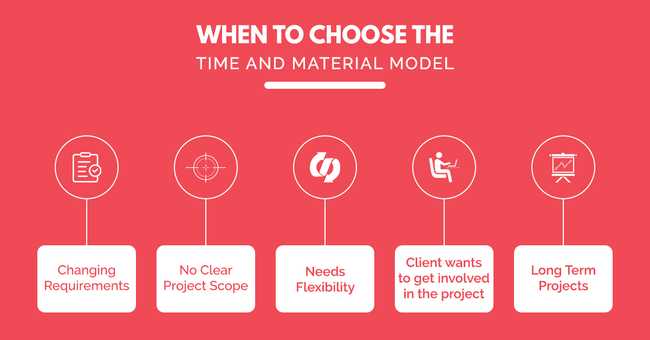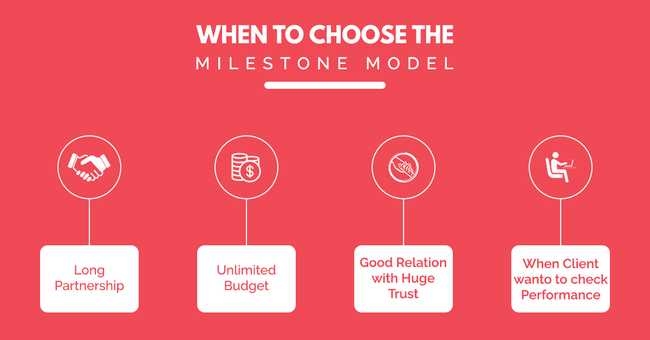Every company can greatly benefit from outsourcing software development tasks to another team.
However, budget plays the main role in such situations.
Sound knowledge of pricing models can ensure project completion in time and within budget. This means neither the client will end up spending more than the estimation nor the developer team will end up developing at their own cost.
Based on the nature of the project, there are 3 mostly used pricing models:
- Fixed Price Model (FPM)
- Time and Material Model (T&MM) &
- Milestone model
Let’s have a close look at the pros and cons of each model.
1. Fixed Price Model
In this model, the price is fixed and so is the quantity of work. The scope of work is clear and well mentioned earlier.
Wireframes are essential for the team involved in development in order to put their hours and include all the features.
During the project, the developer and the client experience scope related risks. They get information on where and when does the project start and stop. In addition, they also know about the job of each party in different phases of the project.
Before the development of software products, they discuss the total budget and the required time period. However, sometimes the client adds a new feature that is not mentioned in the agreement. As a result, the developer team asks for additional payment and an additional agreement is made on this case. In conclusion, this model is all about time and budget.
Pros:
- Fixed budget and timelines. Both parties come to an agreement. Hence, they sign a contract to complete the work within deadlines while price remains the same.
- Good coordination and more trust. The project manager supervises the work progress. Highly motivated team work efficiently to deliver the product. So, there is no room for distrust.
- Minimum risk. The client gets the privilege of payment. It is made only after all the requirements needed for the product is fulfilled.
Cons:
- Lengthy preparation time. It takes two to three weeks for setting up the requirements and timelines.
- Less access to control. The client suggests adjustments according to their requirements. However, the management team controls and executes it.
- Short of communication. The client cannot expect frequent communication with the developer team. Hence, little or no interaction is the drawback of this model.
When to Choose the Fixed Price Model?

Fixed Price Model is best to choose while doing small projects that have limited features and clear requirements. It works best for Minimum Viable Products and those budgets with a limited budget and fixed deadlines. Besides this, you also need to consider many factors before choosing and accesting the fixed price model.
2. Time and Material Model
In this model, the client pays for the completed work at regular intervals.
The client has a crucial role in the development process of the software product. So, good cooperation between the developer team and the client is the heart of T&MM. As a result, they come together to complete the task on time. Unlike FPM, the client alone bears the scope related risks. The addition and removal of features as per the client’s choice without additional charges is the advantage of this model.
Pros:
- Negotiable price. The client can always add or remove the features to keep the total price in check while building the most important feature for business.
- Installment payment benefits. The work is divided into several parts. So, the client pays for the work that has been done.
- Quick commencement. The development process begins as soon as the contract is signed. Hence no time is wasted in creating huge requirement documents that might change in the course of development.
- No arrangement costs. The workflow includes all the discussions and the meetings as part of an ongoing development cycle. Hence, it won’t have costs related to the arrangement of the project at an early phase.
- Agile development process. This model supports the division of tasks into short phases of work, frequent reassessment, and adaptation of plans.
Cons:
- Vague deadlines. The target date is uncertain. So, the completion of the development process is known little.
- Uncertain budget. The client does not know how high the final price will go although each part of the process is discussed prior.
- Time cost. The client has to allocate a handsome amount of time to tune into the management and development process of the project.
When to Choose the Time and Material Model?
Time and Material Model is best to choose when the clients want a flexible process and agile method to execute a project. Since the process is flexible, the requirements are changing. So, it best fits for long term projects. This model is best when there is no clear and precise scope and the clients themselves get involved in the project to make the developers work as per their vision.

3. Milestone Pricing Model
In this model, the client and the developer team set benchmarks or milestones before the beginning of software product development. The client and the team agree to make the payment after achieving the predefined milestone. Unlike T&MM, the bill is paid only after the client is justified with the milestone achieved.
Pros:
- Payment after the achievement. The client has the freedom to pay after the development process to attain some milestones.
- Greater access to control. The client approves the milestone achieved.
- Provision of the checklist. The developer team provides a list of checklists to the client. It helps to track the progress of the work as expected.
Cons:
- No finalized budget. Each functionality requires a different time to complete. The client pays approved prices according to the time it takes to reach the milestone.
- Unending disputes. The client and the developer team encounter disputes over the functionality which the client finds irrelevant to the checklist. It may require a certain time to settle the disputes.
- No strict deadlines. It requires planning and execution again and again to reach each milestone. Hence, the deadline is unsure when the product will get finalized.
- Less trustworthy. The developer team finds this model less trustworthy. Sometimes they turn down the client who insists on it.
When to Choose the Milestone Model?

Trust and good relationships automatically minimize the risk of fraud and disputes. So, this model is best to be used between business partners.
How to Choose the Best Pricing Model?
Every model has its own advantages and disadvantages. So which one to choose? It depends on the market trends and estimated budget. So choose the best pricing model and implement the best pricing strategies for your business.
Hence, after a proper analysis of every influencing factor, it is you who is actually going to make the decision.

Still confused? Truemark can help you decide the best pricing model that will help your business thrive. Contact us to benefit from our free consultation service.
